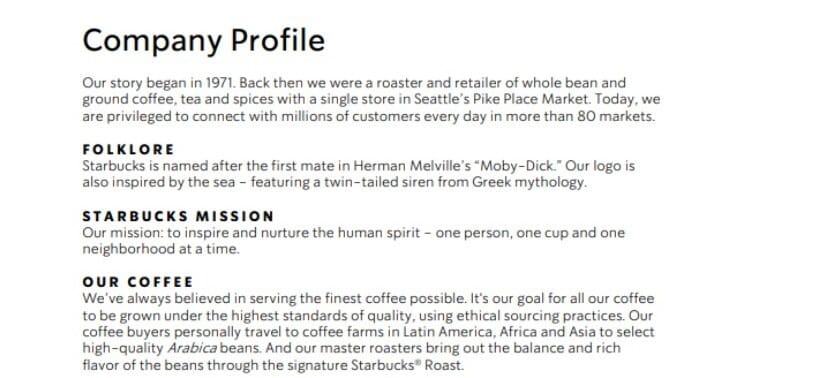If you have just started a new firm andalso want to make a good first impression on potential clients, you must write a strong company profile. A well-written company profile is an efficient way of introducing the company to potential consumers and other stakeholders. It can be frightening if you have never created a company profile before.
We have tips, examples, and also a sample to get you started on how to write this profile for your company.
What Is a Company Profile?
A company profile is a professional summary of the company and its operations. A company profile is required if you want to raise funds and attract investors, but it can also be used to inform other stakeholders, including clients.
A company profile can be written in a variety of styles and lengths. Some companies may not have grown sufficiently and had profiles that are only two pages long. Some, on the other hand, may include awards, certifications, and a large client portfolio, with a maximum of 30 pages.
The bottom line in both situations, as well as those in between, is that a company profile is your company’s time to shine.
10 Easy Steps to Write a Company Profile
Basically, if you want to ensure that you’ve included all of the necessary information to entice your reader, you must flip the traditional business profile on its head and consider what your audience wants to know about your company. To assist you, we’ve identified the most important actions you need to do to establish a fascinating company profile.
#1. Determine the profile’s purpose.
Companies use company profiles for a variety of purposes, such as company websites, trade portfolios, and investment plans. So, before you put pen to paper, you must first determine the goal of the profile. Don’t worry, you can change it later if necessary!
Assume your profile is intended to be displayed on your company’s website. Make a list of topics that your audience would like to read about in relation to your business, and then structure your content. You should also ensure that the tone of the information is appropriate for your intended audience. For example, you don’t want to make it sound stuffy by blasting it with facts because, quite honestly, no one will care (unless you, of course)!
#2. Choose a design style.
Now that you’ve determined the tone you want to set for your profile, it’s time to figure out how you’ll deliver this information. Do you want a standard style divided into sections, or you want it displayed in the form of a timeline? Some organizations, such as Philips, even select a more graphic approach to telling their narrative.
That being said, you should not be frightened of being unique and deviating from the usual, as long as it is consistent with your brand and industry. For example, if you work for an accounting business, you should definitely keep to the usual structure. This includes information about recent awards and achievements.
#3. Tell us a story.
When you’re attempting to get people to pay attention to your company, you need to tell a compelling tale. It is not enough to merely give dates and figures; you must ensure that your reader is on board while leading them through your company’s journey.
Whether you started with a lemonade stand or grew up in the family business, how you tell your story is the most crucial element. After all, not every story will be as thrilling as the next. Consider Zappos company profile sample as one of the examples of a popular brand that has perfected the art of storytelling.
#4. Create an outline for your mission statement.
If you don’t already have a mission statement, it’s time to get down to business and also craft an enticing statement about your company’s beliefs, ethos, and niche. You must inform your readers of the services you provide and how you intend to expand your business, essentially informing them why they should select you over a competitor.
For example, Disney’s mission statement encourages you to believe that they will deliver the most creative entertainment experience in the world: “The Walt Disney Company’s objective is to be one of the world’s premier creators and providers of entertainment and information.” We aim to create the most creative, inventive, and profitable entertainment experiences and related products in the world by using our brand portfolio to differentiate our content, services, and consumer items.’
#5. Maintain a consistent format throughout.
When it comes to drafting a business profile, some creative individuals can let their imagination run wild. So, if you’re one of those people, take note of the following advice! You must verify that your format is consistent. Use the same font and size, for example, in the body of your text and in your headers.
Don’t overburden your profile with irrelevant images and out-of-place colors. Stick to those that complement the rest of your brand. For example, at CareerAddict, they use specific fonts and colors (black and orange) that are carried through all of our products, including our social media channels.
#6. Create a timeline of the company’s history.
Jumping from the past to the present and back again will only confuse your reader. So, list the company’s history chronologically. However, it is totally up to you whether this is done in the form of a timeline or paragraphs. It is vital to ensure that it flows and makes sense to the reader. It is critical not to become bogged down by too many details when doing so. Instead, highlight major accomplishments to demonstrate how your organization got to where it is today. If you own a small firm, you can include details about the brand’s establishment and growth.
#7. Incorporate testimonies
An excellent testimonial can increase the value of your brand by providing future customers with feedback from another consumer. In a B2B business, testimonials from your most important clients are perfect. Short quotes with feedback that relates to your beliefs, on the other hand, work well in a B2C organization. You want to provide genuine comments to the reader without appearing too promotional.
#8. Include your contact details
Now that you’ve gotten the critical stuff out of the way, it’s time to fill in the blanks with some valuable information! If you intend to use your company profile offline, include your address, phone number, email address, and fax number (if applicable) at the beginning of the document. Meanwhile, if your company profile is intended for a website or other online forums, simply write your contact information at the bottom of the page as a hyperlink.
#9. Include a call to action.
If you want to put the final touches on your company profile (and who doesn’t?! ), include a call to action at the conclusion. This may be something like, ‘To learn more, visit our website’ or ‘Contact us for additional information.’ Essentially, you should leave the reader with some food for thought as well as a way to find the answers to their queries.
#10. Double-check it
Finally, it is critical to proofread your corporate profile to ensure that there are no errors. After all, it’s one of the most significant pieces of literature associated with your company! When you’ve been gazing at the same piece of text for hours on end, it’s easy to overlook little problems, which is why you should have another pair of eyes go over it. And don’t forget to keep your company profile up to date!
Many entrepreneurs create their profiles once and then forget about it a year later. To avoid doing the same thing, schedule an annual calendar reminder to update your profile to keep up with the way your business is growing.
Examples of Company Profile
#1. Starbucks

This is one of the excellent examples of how a company profile should look. Starbucks begins with a brief history of the company and how it has changed over time. It also incorporates Starbucks’ trusted mission statement to ensure that all employees and consumers can relate to the company’s ethos.
With a strong brand identity and aim, the coffee brand manages to stand out from the crowd, as demonstrated in this company profile. ‘Our mission: to inspire and nourish the human spirit,’ they say, and they do it through a variety of branding and philanthropic initiatives. They are more than just a coffee shop; they have established themselves as a gathering spot for individuals of all ages, ethnicities, and origins.
#2. Nike

Nike performs a wonderful job of showcasing that they are an inclusive brand inside their company profile. From the minute you access their page, you can see that Nike is far above a typical sports gear firm. They want their clients to feel like they are part of a community when they wear one of their goods. Furthermore, they emphasize early on that they are an inclusive employer with a diverse team and that they give back to their community through charity work. Working with Nike is like becoming a member of a large family with a strong mission – something that every employee would want to be a part of.
#3. Zappos

Also, Zappos like Starbucks, opens their company biography by telling the tale of how they got started and how they’ve changed through time. Their narrative alone is motivational for anyone who aspires to construct their own. Zappos identifies who they are as a brand, their philosophy, and why corporate culture is at the center of all they do through specific sections. They demonstrate that they are much more than an eCommerce company and are more of an online community in which everyone should participate.
How can a company profile be used to build and maintain relationships with stakeholders?
A company profile can be used to build and maintain relationships with stakeholders such as customers, investors, employees, and suppliers. By showcasing the company’s values, vision, and mission, stakeholders can gain a better understanding of the company’s goals and objectives. Additionally, highlighting the company’s achievements and awards can help build trust and credibility with stakeholders, which can help strengthen relationships over time.
Can a company profile be used to showcase a company’s achievements and awards?
Definitely! A company profile can be a great way to showcase a company’s achievements and awards. This information can help build credibility with stakeholders and demonstrate the company’s level of expertise in its field. Including details such as the date of the award and the organization that presented it can help add weight to the achievement.
How can a company profile be used to differentiate a company from competitors?
A company profile can be used to differentiate a company from competitors by highlighting the company’s unique strengths and characteristics. This can include the company’s mission, values, and brand personality, as well as details about the products and services it offers. By showcasing what sets the company apart from others in its industry, a company profile can help attract customers and set the company apart from the competition.
What role does a company profile play in a company’s overall branding strategy?
A company profile plays a crucial role in a company’s overall branding strategy. It serves as a summary of the company’s brand identity, highlighting its values, mission, and personality. By providing a clear picture of the company to stakeholders, a company profile can help establish a strong brand image and reputation. Additionally, a well-crafted company profile can help attract customers and build trust, which can contribute to the overall success of a company’s branding efforts.
How often should a company profile be updated?
It’s recommended that a company profile be updated regularly, at least once a year or whenever there are significant changes to the company’s structure, products, services, or overall mission. Keeping the profile up to date helps ensure that stakeholders have accurate and relevant information about the company, and can help maintain the company’s credibility and reputation.
Summary
By following these simple suggestions and the examples and sample above, you will guarantee that your company profile aligns with your branding strategy, allowing you to communicate the ethos of your firm and, eventually, attract new consumers and potential workers. Do you have any further tips on how to write an effective company profile? Please share your thoughts in the comments box below!
Company Profile FAQs
How do you write a company profile?
Steps to writing a company profile
- Identify the profile’s purpose. …
- Decide on a style. …
- Tell a story. …
- Outline your mission statement. …
- Keep a consistent format throughout. …
- Write the company history in chronological order. …
- Include testimonials. …
- Include your contact information.
How do you introduce a company profile?
How to write a business introduction letter
- Determine the intent.
- Research the company or market.
- Identify a need.
- Open with a strong statement.
- Include relevant details.
- Keep it short and concise.
- Create a call to action.
- Close your letter.
What is the difference between business profile and company profile?
A business profile also called a company profile or business introduction is written in a narrative form that outlines the key elements regarding the specific business. Although the business profile serves a purpose similar to a resume of the company, it appears more like a summary
- Customer Lifetime Value CLV: How to Calculate the Customer Lifetime Value
- Fortune 500: Definition, Techniques, & Factors for Ranking
- Market Profile: What you need to know simplified & explained
- 20 Economical Ways To Make Your Online Business Effective In 2018
- FREELANCING BUSINESS: 2021 Models and Ideas to consider starting out






